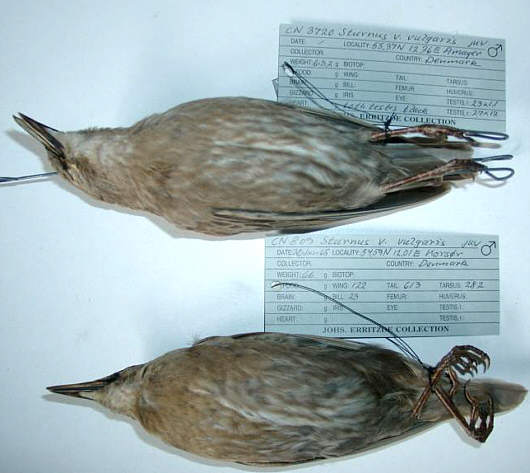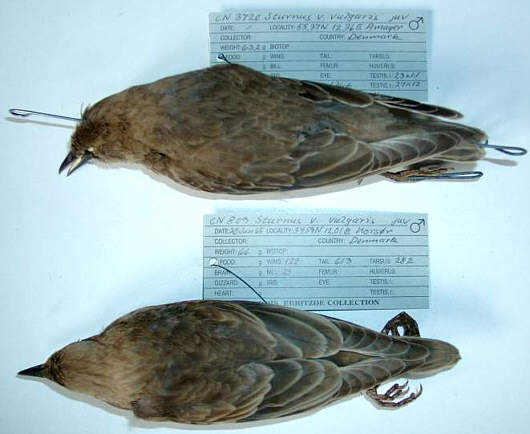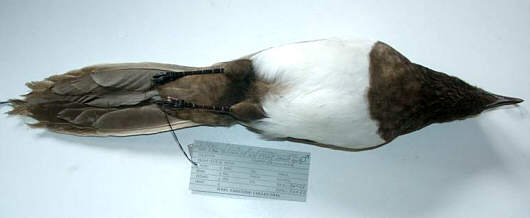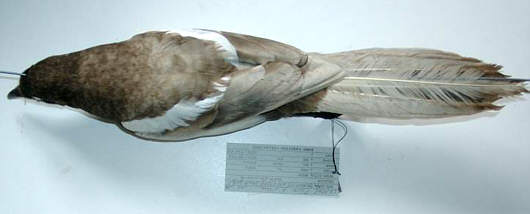Leucism
Leucism: 'Partial loss of pigment, effecting all the colours present and reducing them in intensity, is rare. It is called 'dilution' by bird breeders and 'leucism' in scientific writings, although the latter term is also used at times for various forms of schizochroic loss of single pigments which make the plumage appear paler'. 'Schizochronism: One or more pigments absent in the plumage leaving white areas on feathers where the missing pigments would normally be present, unless another pigment also occurs on this part of the feather and now appear alone. Usually only found in females in the wild' (Campbell & Lack 1985: 472).


CN 3720
Leucistic Common Starling Sturnus v. vulgaris male juv
no date, 55.37N 12.36E Amager, Denmark
Weight 63.2g, Testes, left 2.3 x 1.1, right 2.7 x 1.2, both black. Skull
not ossified, no grit, food insects. Tail tips worn. Both birds resembling
Rose-coloured Starling Sturnus roseus.
CN 809
Leucistic Common Starling Sturnus v. vulgaris male juv
20 June 1965, 54.59N 12.01E Korsør, Denmark
Weight 66g. Plumage not worn.


CN 3065
Leucistic Black-billed Magpie Pica p. pica male juv
2 November 1973, 55.16N 09.38E Stevelt Lysby, Denmark
Weight 224.5g, testes left 3.6 x 2.2, right 4.2 x 2.2, bursa Fabricii
11.0 x 8.2.
Bill brown, legs brown-black. 7 fault bars in worn tail.
My three leucistic birds are all males. This could be an accident. A search through the literature gave not much information, because only a Turdus merula was sexed, but also as a male (Hodge 1986). They are also all young birds, which is not surprising because pale birds are more liable to predation and the reduced pigmentation weaken the feathers with more abrasion and wear and so less manoeuvrable (Campbell & Lack 1985).
A survey through Zoological Record from 1973 to 1992 to see in which
species this phenomenon occur gave the following result:
15 Larus argentatus. (white, grey-blue, black, juvenile brown plumage
colours)
9 Passer domesticus. (brown, grey, male also black)
7 Turdus merula. (black, female and juvenile brown)
6 Hirundo rustica. (glossy blue-black, white, red-brown)
5 Larus ridibundus. (white, grey-blue, dark brown, black, juvenile brown)
4 Cygnus columbianus, Larus canus, Vanellus vanellus. (white, juvenile
brown; white, grey-blue, black, juvenile brown; glossy green, white, black,
buff, juvenile brown)
3 Charadrius hiaticula, Dacelo novaeguineae, Haematopus ostralegus, Sturnus
vulgaris, Uria aalge.
2 Alauda arvensis, Anser fabalis, Anthus spinoletta, Apus apus, Branta
canadensis, Buteo jamaicensis, Columba palumbus, Corvus frugilegus, Cygnus
olor, Dendragapus obscurus, Emberiza calandra, Fratercula arctica, Galerida
cristata, Gallinago gallinago, Gavia immer, Lanius collurio, Larus minutes,
Parus caeruleus, Phasianus colchicus, Podiceps cristatus, Pycnonotus barbatus,
Pyrrhocorax graculus, Remiz pendulinus, Turdus iliacus, T. viscivorus.
1 Acrocephalus schoenobaenus, Alopochen aegyptianus, Anas penelope, A.
platyrhynchos, Anous
tenuirostris, Anser anser, Ardea goliath, Asio flammeus, Bulweria bulweria,
Buteo buteo, Calidris alpina, Corvus macrorhynchos, Dendragapus obscurus,
Dinopium benghalense, Diomedea cauta, D. immutabilis, Emberiza citrinella,
E. schoeniclus, Erithacus rubecula, Erythura gouldiae, Euplectes albonotatus,
E. capensis, Falco sparverius, Francolinus afer, Fregata minor, Fringilla
coelebs, Fulmaris glacialis, Grus grus, Hirundo tahitaca, Lamprotornis
mevesii, Larus delawarensis, L. fuscus, L. marinus, Meliphaga fasciogularis,
Mirafra africana, Perdix perdix, Phalacrocorax carbo, Phoenicurus ochruros,
Prunella modularus, Podiceps nigricollis, Pterodroma phaeopygia, Puffinus
lherminieri, P. opisthomelas, P. puffinus, P. tenuirostris, Rissa tridactyla,
Saxicola torquata, Sayornis phoebe, Sialia mexicana, Spreo pulcher, Sterna
fuscata, Streptopelia decaocto, Thryothorus ludovicianus, Tringa nebularia,
Turdus philomelos.
Most of the leucistic records from Zool. Record are of Palearctic origin 49, Nearctic 16, Ethiopian 10, Oceania 7, Oriental 4, Australasian 4, Worldwide 1, and Neotropical 0. The low numbers from both the New World and Australia are surprising the many active ornithologists in these areas taken into consideration.
The frequency of the recessive gene controlling leucism seems to be more
frequent in some families than in others. The families with most leucistic
individuals were:
Laridae: 10 species, 32 individuals
Anatidae: 8 species, 14 individuals
Turdidae: 8 species, 14 individuals
Procellariidae: 7 species, 7 individuals
Phasianidae: 4 species, 5 individuals
Corvidae: 3 species, 5 individuals
Sturnidae: 3 species, 5 individuals
Most of the bird species where leucism are recorded have brown to red-brown,
white, grey and black feather colours. Only a few have yellow, red, green,
blue, or violet colours. The exceptions are: Anas penelope (male a little
yellow on crown), A. platyrhynchos (male glossy green head), Dinopium
benghalense (male top of head red), Emberiza citrinella (head and underparts
yellow), Erithacus rubecula (breast red), Erythrura gouldiae (green upperparts,
head red or yellow, breast violet), Euplectes albonotatus (male and female
yellow on lesser upper wing-coverts), E. capensis (male has yellow less
on upper wing-coverts and rump), Hirundo rustica and H. tahitaca (both
glossy blue upperparts), Lamprotornis mevesii (whole body glossy blue-green),
Meliphaga fasciogularis (green wings, yellow malar stripe), Parus caeruleus
(blue on top of head and wings), Phasianus colchicus (glossy blue on neck),
Pycnonotus barbatus (yellow under tail-coverts), Sialia mexicana (blue
head, upperparts, wings and tail), Spreo pulcher (red and glossy green),
Vanellus vanellus (glossy green upperparts and wings)
References and supplement to Zool. Record bibliography of leucism.
Brix, M. 1999: Zum Aussehen und Verhalten leuzistischer Ringelgänse. Ornithol. Mitt. 51: 316.
Bobcik, J. 2000: [A leucistic individual of the Crested Lark (Galerida
cristata) occured in Hodonin]. Zpr. Ceské Spol. Ornitol. 51: 20.
(English summary.)
Campbell, B. & E. Lack. 1985: A Dictionary of Birds. T & A D Poyser, Calton.
Cleeren, L. 1993: Brown coloured Magpies. Oriolus 59: 44. (Pica pica).
Collins, P. & R. Jessop. 1997: Leucistic Star Finch near Wyndham, Western Australia. Aust. Bird Watcher 17:106. (Neochmia ruficauda).
Conings, A. 1996: ['Biscuit-coloured' Common Starling in nest at Weerselo in May1995]. Dutch Birding 18: 244-245. (Sturnus vulgaris juvenile).
Crewe, M. 1993: Leucistic Wheatear at Felixstowe. Suffolk Birds 42: 143-144. (Oenanthe oenanthe).
Crook, R. B. 1993 (1991): A leucistic House Finch at the feeder. Maryland Birdlife 47 (4): 145-146. (Carpodacus mexicanus).
Davis, W. E. & H. F. Recher. 1996: A leucistic Australian Magpie Gymnorhina tibicen dorsalis in Western Australia. Aust. Bird Watcher 16: 303-304.
Degn, H. J. 1974: [Leucistic Magpies]. Dansk Orn. Fore. Tidsk. 69 (1-2): 66-67. (Is not recorded under leucism in Zool. Record 1974: 219)
Duvic, M. V. Year?: Leucistic Ruby-throated Hummingbird near Byram, Mississippi. Mississippi Kite 19: 17-18. (Archilochus colubris).
Eakin, R. R. 1994: A leucistic Sharp-shinned Hawk in Portland, Maine. Maine Nat. 2: 29-30. (Accipiter striatus)
Forrest, S. C. & R. Naveen. 2000: Prevalence of Leucism in Pygoscelid Penguins of the Antarctic Peninsula. Waterbirds 23: 283-285.
Gutiérrez, R. 2000: Leucistic Northern Chiffshaff in Spain in November 1999. Dutch Birding 22 (3): 147-149. (Philloscopus collybita).
Hek, T. 1996: Leucistic Redwing on Terschelling on January 1996. Dutch Birding 18: 308. (Turdus illiacus).
Heunks, E. 1999: [Leucistic Great Reed Warbler near Tienhoven. Dutch Birding 21 (2): 100. (Acrocephalus arundinaceus).
Hodge, A. R. 1986: Blackbird with aberrant plumage. Devon Birds 40 (1): 18.
Jaramillo, A. 1995: Leucistic Glaucous-winged Gull Larus glaucescens. Birders Journal 4: 204.
Kratzer, D. & R. Kratzer. 1994: Leucistischer Raubwürger (Lanius excubitor) bei Oberndorf/Tübingen. Ornithol. Schnellmitt. Baden-Württ. 42: 42-67.
Lehto, H. J. & H. Lehto. 1995: Leucistic Great Grey Owl in Finland in March-April 1994. Dutch Birding 17: 19-20. (Strix nebulosa)
Lehto, H. 1998: The red Magpies. Alula 4 (1): 16-17. (Pica pica)
McMahon, J. A. 1994: Leucistic Swainson's Thrush in Muskogee Country, Oklahoma. Bull. Orn. Soc. 27: 31. (Catharus ustulatus).
Niesz, J. 1993: Leucitic Moorhen. Oriolus 59: 43. (Gallinula chloropus).
Owen, M. & P. Shimmings. 1992: The occurrence and performance of leucistic Barnacle Geese ranta leucopsis. Ibis 134: 22-26
.Peltomäki, J. 1998: Again leucistic Great Grey Owl in Finland in March 1998. Dutch Birding 20 (6): 296. (Strix nebulosa).
Rasmussen, S. A. 1974: [More about brown Magpies]. Dansk Orn. Foren. Tidskr. 68 (3-4): 148. (Pica Pica). (Is not recorded under leucism in Zool. Record 1974: 219)
Remeeus, A. 1977. Waarneming van een leucistische grauwe klauwier Lanius collurio bij Wassenaar. Limosa 50, 3/4: 147-148.
Remeeus, A., R. Kampf en, & C. C. M. Kampf-Rekelhof. 1979. Waarneming van een gedeeltelijk leucistische familie grauwe klauwier Lanius collurio bij Wassenaar in 1977. Limosa 52, 1/2: 75-76.
Sønder, E. 1974: [A reddish-coloured Wren Troglodytes troglodytes]. Dansk Orn. Foren. Tidskr. 68 (3-4): 148-149. (Is not recorded under leucism in Zool. Record 1974: 219)
Wink, P. 1995: [Record of a leucistic Lesser Black-backed Gull]. Anser (Harderwijk) 3: 6-7. (Larus fuscus).
Withgow J. H. & J. A. McMahon. 1993: Conspecific harassment
of a leucistic Barn Swallow. Bull. Oklahoma Orn. Soc. 26 (4): 38-39. (Hirundo
rustica)